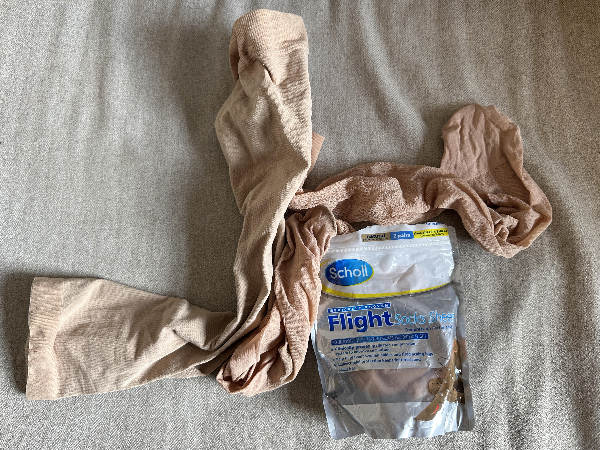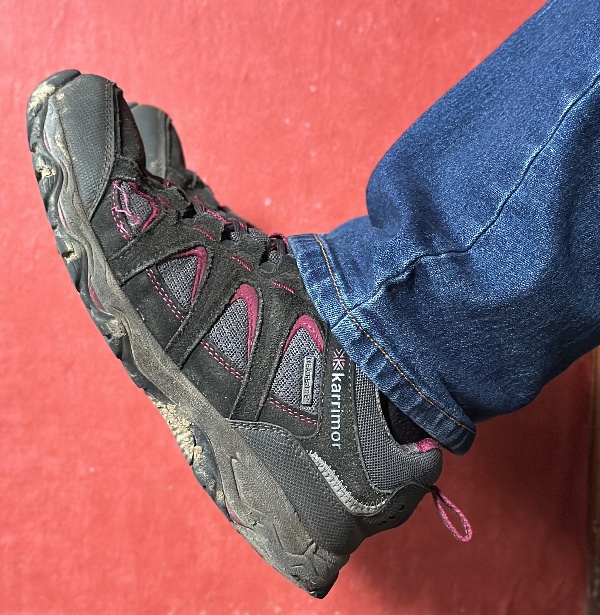Some seasoned travellers wear compression socks all the time, while others don’t bother. But should you wear them? Staying seated for long periods can be detrimental to your health; compression socks can help alleviate some of the issues.
What are compression socks?
Compression socks contain elastane, allowing them to stretch. They squeeze and stimulate circulation in your calves and feet. There are medical compression socks, which are tighter at the bottom and looser at the top, and are prescribed by a doctor. However, for flights, a non-medical sock will suffice; these are often referred to as flight socks.
Why do we need these socks?
Usually, your calf muscles send blood back up through your circulatory system. However, when you sit down for an extended period, the muscles don’t move much, and since veins don’t have a plumbing system, your circulation does not work very well. A compression sock helps blood flow more efficiently and prevents blood pooling.
Health Risks
Deep Vein Thrombosis
Deep Vein Thrombosis (DVT) occurs when individuals are immobile, causing blood to stagnate and potentially leading to the formation of clots. This is particularly dangerous if the clot breaks off and becomes lodged in the lung, as this can be life-threatening.
If, after a flight, you notice
- Swelling or pain in a leg
- Warm skin
- Heavy ache
- Red patch of skin
- Breathing difficulties
Get it checked out by a doctor immediately.
You can get painless puffiness in the ankles and feet after a long journey, so don’t be anxious, this has nothing to do with DVT. However, if you are unsure if it is more than just a minor swell, seek medical advice.
Usually, the discomfort is in just one leg, but not always. The discomfort can develop during the journey, but usually hours or even days later.
Often, however, there are no symptoms; this is why flight socks are a good idea.
Leg Swelling
When sitting down for extended periods, blood can accumulate in the feet and legs, potentially leading to swelling and discomfort. I have found this happens to me when driving for long periods on road trips. It can take a day or two for the swelling to subside, only after I sit with my leg raised. It can make walking or putting on shoes uncomfortable.
Varicose veins
The backup of blood flow can cause varicose veins, which don’t look great, but can also lead to numerous health problems.
Arches and pains, including restless legs
Sitting down for long periods can cause your legs to ache or feel uncomfortable. You can experience restless legs when you feel the need to constantly move them, as they never feel comfortable. If you are already tired, it increases the chances of getting restless legs. It is better to wear socks before your legs become uncomfortable, as once they are causing you problems, it is harder to resolve the issue.
When to wear them
You don’t need to wear them on short trips under 3 hours. Some experts recommend wearing them if the flight is over 5 hours, while others suggest it’s over 4 hours. If you are at high risk, I would wear them for any flight over 3 hours. They should also be worn if you take multiple flights over a short period.
They should be worn the whole time you are on the flight.
Who needs to wear compression socks?

Everyone would benefit from wearing compression socks, but some individuals are at a higher risk of developing DVT, making it more critical for them to wear flight socks.
It covers a lot of people.
- If you take the oral contraceptive pill or tablets for HRT
- If you are overweight or over 190cm (6 feet 2 inches) or under 160 cm (5 feet 2 inches)
- If you are over 60 years old
- If you’re not very mobile, or have recently been ill in bed for a while
- If you are pregnant
- If you or a close relative has had DVT or pulmonary embolus
- If you have surgery on your legs or pelvis in the last couple of months
- If you are prone to blood clots
- If you have cancer or have recently had heart failure or a heart attack.
- If your leg is in plaster
- If you become dehydrated
Who shouldn’t wear compression socks?
- If you have skin that’s easily bruised.
- If you have peripheral vascular disease affecting your lower legs.
- Diabetic patients should be careful as they might not notice any changes in their feet.
Buying compression socks

You can purchase compression socks online or find them at supermarkets or chemists during the summer holiday season. You can purchase them from airports, but I suggest buying them several weeks before your holiday so you can try them on.
There are various types of compression socks, as well as compression tights. There are compression tights that don’t have toes, which can be helpful if you’re wearing an open-toe shoe. They have socks in a variety of colours, styles, and sizes. At one time, you could tell it was a compressing sock just by looking at it, but now it’s hard to tell without a close examination. I now find mine are getting mixed up with my regular socks.
You buy the socks according to your shoe size. However, online, you can buy socks according to your ankle and calf size as well as your shoe size.
Flight socks vary a lot in how compressed they feel. You should be able to feel a slight compression, but it shouldn’t be so tight that it hurts. If you have fatter or thinner legs than average, you may need to try a few pairs before finding one that is both comfortable and effective.
If you are petite, ensure the sock finishes below your knee or extends completely over your knee. Otherwise, it can be uncomfortable.
The material should be breathable to help keep the sweat away from your skin; nylon and polyester blends with elastane work well.
Washing your socks
The socks should be washed by hand. Otherwise, they might get damaged and lose their compression.
I suggest that when you arrive at your destination, give them a quick dip in a hand basin and a rub with soap, then gently squeeze them (do not ring out), and leave them to dry.
If you don’t do it at the beginning of your holiday, you could find a disgusting, smelly pair of socks which you don’t want to wear on your return journey.
When to put them on
You won’t be able to put your socks on when you’re seated in an economy seat on your aircraft, unless you have extra legroom. I tend to put my socks on when I arrive at the airport or at home if I have only a short trip ahead.
How to put your socks on
The socks are tighter than usual, making them harder to put on. It is essential that they are smooth with no creases, as they may pinch your skin. If they are long, make sure they don’t pinch the back of your knee when you sit down.
What can I do if I don’t wear compression socks?

If you can’t wear compression socks, or, like my family, forget to pack them, or, like me, can only find one of them, then you should do exercises.
- Getting up and walking along the aisle is helpful but not always possible. Often, trolleys are in the way, or the seatbelt sign is on.
Do these exercises while sitting down-
- Ankle Circles. Lift your feet off the ground and twirl your feet in circular motions, five times in one direction, then five times in the other.
- Foot pumps. Keep the heels of your feet on the ground, and then lift the balls of your feet up and down repetitively. Rest, and then repeat.
- Raise your heels off the floor as high as possible, then lower them back down. Repeat this movement several times.
- Knee lifts. Lift your knee to your chest. You can pull your knee a bit closer if you wish. Hold, then release. Repeat with the other knee.
You can often find foot exercises shown on flight information screens or in-flight magazines.
Whenever my family members forget their flight socks, I remind them to do the exercises; they do them once and then fail to do them again. If you spend your time watching films, it’s a good idea to do the exercises every time you finish a film. Otherwise, aim for every couple of hours.
It is not possible to do exercises if you are asleep. Medical professionals recommend avoiding sleeping tablets and instead take short naps. If you are likely to sleep for most of the journey, it’s best to wear compression socks.
It is thought that bending your knee at 90 degrees may reduce blood flow, so if possible, stretch your legs out. If there is room, rest your feet on a bag or other item under the seat in front of you to adjust the angle of your knee.
Walking around for 30 minutes before boarding your aircraft is also thought to help.
Drink water
I know everyone says drink more water, but this is one of the times when you don’t want to cut back on your liquids. Some people choose not to drink much on planes so they don’t need to get up and use the toilets, especially if they have a window seat. This can lead to dehydration. Dehydration can cause the blood to become thicker and sticky, which increases the risk of thrombosis. Don’t drink excessive amounts of water, as that can also be detrimental, but instead ensure you don’t cut back on your liquid intake.
Avoid excessive alcohol

It is recommended not to drink in excess because it can cause dehydration. It also causes people to fall asleep and not move enough.
Aspirin
At one time, Aspirin was recommended to reduce DVT on flights, but most medical professionals no longer recommend this. Aspirin doesn’t reduce DVT as it is not very effective at reducing clots in veins and does have side effects, which can cause other problems.
Summary
DVT can be serious, so it’s best to take precautions to avoid it. The risk is low, but passengers should be aware of the consequences and who is at greater risk. The risk increases with the duration of the journey; for journeys exceeding 16 hours, the risk is approximately 1 in 1,200 of a clot forming, but necessarily causing a problem. Although I have been talking about flights, DVT can also occur on long train or coach journeys. If you get any signs of DVT, have them checked by a medical professional immediately.
Wear the socks or do the exercises, then enjoy your holiday. Keep safe and well.

Leave a Reply